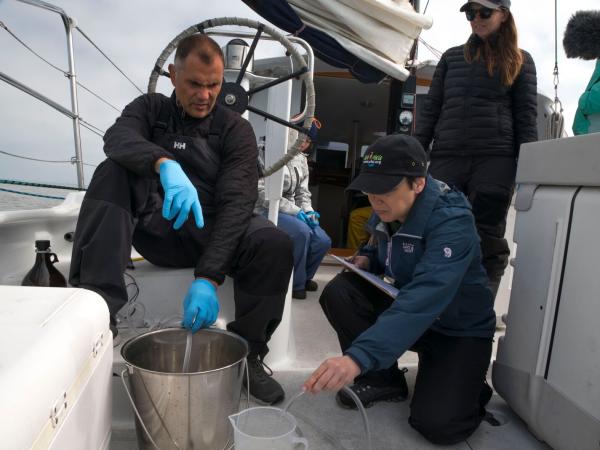Workgroups
Projects Related to the Workgroups
 Statewide Plastics Monitoring Plan & Strategy
Statewide Plastics Monitoring Plan & Strategy
Plastics, in their various chemical composition and sizes, pose serious challenges to the vitality of California's ecosystems. Once escaped into the environment, plastic contamination persists for very long periods and breaks down into ever smaller pieces, becoming more readily available to wildlife and populations who live, work, and play in those same habitats.
 California Pesticides: A Data Visualization Tool to Link Pesticide Use and Management to Water Quality
California Pesticides: A Data Visualization Tool to Link Pesticide Use and Management to Water Quality
Despite California's data-rich environment, there are still many obstacles when trying to access and understand pesticide data at the nexus of water quality, ecological effects, and human health. We recognize a need to fill data gaps, not necessarily by collecting new data, but by better leveraging information already technically in the public domain. The goal of this project is to bring pesticide reporting, occurrence, and toxicity data together in ways that yield insights and meet the expressed needs of stakeholders in clear, efficient, credible, and repeatable ways.
 Perfluoroalkyl and Polyfluoroalkyl Substances (PFAS)
Perfluoroalkyl and Polyfluoroalkyl Substances (PFAS)
A recent analysis of PFAS in the surface waters of SF Bay was conducted to understand the occurrence, fate, and potential risks to ecological and human health. Eleven of 40 PFAS were detected at part per trillions (ppt) concentrations in ambient water collected in 2021 from 22 sites in the Bay. Seven PFAS (PFPeA, PFHxA, PFHpA, PFOA, PFBS, PFHxS, and PFOS), were found in at least 50% of samples. Concentrations of PFAS in the Bay were generally consistent with similar studies globally for surface water. Sustained, multi-matrix monitoring of this important class of contaminants of emerging concern is a high priority for the RMP.
 Microplastic Pollution in San Francisco Bay
Microplastic Pollution in San Francisco Bay
Plastic pollution is gaining global recognition as a threat to the resilience and productivity of ocean ecosystems. However, we are only just beginning to understand the scope and impacts of microplastic particles (less than 5 mm) on coastal and ocean resources, and the San Francisco Bay Area is no exception. A preliminary study of nine water sites in San Francisco Bay, published in 2016, showed greater levels of microplastics than the Great Lakes or Chesapeake Bay.
 Contaminants of Emerging Concern Strategy
Contaminants of Emerging Concern Strategy
More than 100,000 chemicals have been registered or approved for commercial use in the US. For many of these chemicals, major information gaps limit evaluations of their potential risks, and environmental monitoring of these chemicals has not been required by regulatory agencies. Nevertheless, researchers and government agencies have begun to collect occurrence, fate, and toxicity data for a number of these chemicals.
Publications related to the Workgroups
The Institute has collectively produced more than 1300 reports, articles, and other publications over the course of its 24-year existence. The following list represents those publications associated with this individual program and its focus areas.
Nothing found
Year of Publication: 2021
2020 Bay Margins Sediment Study Cruise Plan. Richmond, California: San Francisco Estuary Institute; 2021 . Report No.: 1073.  (1 MB)
(1 MB)
. 2021 RMP Water Cruise Plan. Richmond, California: San Francisco Estuary Institute; 2021 . Report No.: 1050.  (1.52 MB)
(1.52 MB)
. Assessment of emerging polar organic pollutants linked to contaminant pathways within an urban estuary using non-targeted analysis [Internet]. Environmental Sciences: Processes and Impacts; 2021 . Report No.: 1107. https://pubs.rsc.org/en/content/articlelanding/2021/em/d0em00463d#!divAbstract
. A Synthesis of Microplastic Sources and Pathways to Urban Runoff. Richmond, CA: San Francisco Estuary Institute; 2021 . Report No.: 1049.  (9.17 MB)
(9.17 MB)
. A ubiquitous tire rubber-derived chemical induces acute mortality in coho salmon. Science [Internet]. Science; 2021;371(6525):185-189. https://www.science.org/doi/10.1126/science.abd6951
. Conceptual Model to Support PCB Management and Monitoring in the Steinberger Slough/Redwood Creek Priority Margin Unit. Richmond, CA: San Francisco Estuary Institute; 2021 . Report No.: 1009.  (17.57 MB)
(17.57 MB)
. Coyote Creek Watershed Reassessment 2020: 10-Year Reassessment of the Ecological Condition of Streams Applying the California Rapid Assessment Method, Santa Clara County, California. Richmond. CA: San Francisco Estuary Institute; 2021 p. 131. Report No.: 1043.  (59.63 MB)
(59.63 MB)
. Holistic Assessment of Microplastics and Other Anthropogenic Microdebris in an Urban Bay Sheds Light on Their Sources and Fate. Environmental Science and Technology Water [Internet]. 2021;. https://pubs.acs.org/doi/abs/10.1021/acsestwater.1c00017#
. Hydrodynamic, sediment transport, and sediment flocculation data from south San Francisco Bay, California, summer 2020 [Internet]. United Sates Geological Survey; 2021 . https://www.sciencebase.gov/catalog/item/60283d79d34eb120311398cd
. Microplastics and other anthropogenic particles are prevalent in mussels from San Francisco Bay, and show no correlation with PAHs. Environmental Pollution [Internet]. 2021;271. https://doi.org/10.1016/j.envpol.2020.116260
. PCBs in Shiner Surfperch in Priority Margin Areas of San Francisco Bay. 2021 . Report No.: 1054.  (7.81 MB)
(7.81 MB)
San Francisco Bay North Bay Margins Sediment Report. Moss Landing, California: Marine Pollution Studies Lab; 2021 .  (1.2 MB)
(1.2 MB)
. San Francisco Bay Regional Watershed Modeling Progress Report, Phase 1. Richmond, CA: San Francisco Estuary Institute; 2021 . Report No.: 1038.  (8.84 MB)
(8.84 MB)
. Simulating Sediment Flux Through the Golden Gate. Prepared for Regional Monitoring Program for Water Quality in San Francisco Bay (RMP). Richmond, CA: San Francisco Estuary Institute; 2021 . Report No.: 1033.  (8.39 MB)
(8.39 MB)
- ‹ previous
- 4 of 14
- next ›
